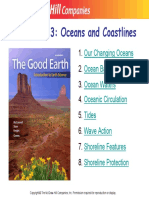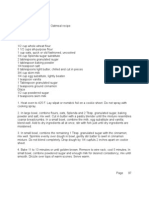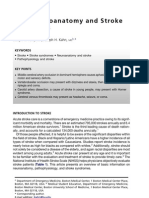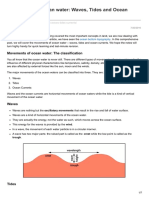Bodies of Water
Bodies of Water
Uploaded by
Mary Karen Rose BorjaCopyright:
Available Formats
Bodies of Water
Bodies of Water
Uploaded by
Mary Karen Rose BorjaCopyright
Available Formats
Share this document
Did you find this document useful?
Is this content inappropriate?
Copyright:
Available Formats
Bodies of Water
Bodies of Water
Uploaded by
Mary Karen Rose BorjaCopyright:
Available Formats
Bodies of Water
1. Cove is a small type of bay or coastal inlet. They usually have narrow, restricted entrances,
are often circular.
2.Bay is an area of water mostly surrounded by land. Bays generally have calmer waters than
the surrounding sea, due to the surrounding land blocking some waves and often reducing winds.val, and are often inside a larger bay.
3.Creek, a small stream, creek (tidal), an inlet of the sea, narrower than a cove. 4.Marsh, or morass, is a type of wetland that is subject to frequent or continuous flood.[1]
Typically the water is shallow and features grasses, rushes, reeds, typhus, sedges, other herbaceous plants, and moss
5. Lake is a body of relatively still fresh or saLakes are inland and not part of the ocean and
therefore are distinct from lagoons, and are larger and deeper than ponds.
7. Gulf (geography), a large bay that is an arm of an ocean or sea
localized in a basin, that is surrounded by land.
water of considerable size,
8. Brook [noun] a natural stream of water smaller than a river (and often a tributary of a river);
9.Sea (n.) The swell of the ocean or other body of water in a high wind; motion of the water's
surface; also, a single wave; a billow; as, there was a high sea after the storm; the vessel shipped a sea
10.Ocean (from Greek , "okeanos" Oceanus[1]) is a major body of saline water, and a
principal component of the hydrosphere. Approximately 71% of the Earth's surface (~3.6108 km2 ) is covered by ocean, a continuous body of water that is customarily divided into several principal oceans and smaller seas.
11. Estuary is a partly enclosed coastal body of water with one or more rivers or streams
flowing into it, and with a free connection to the open sea.[
12. Stream is a body of water with a current, confined within a bed and stream banks.
depending on its locale or certain characteristics
You might also like
- World's Oceans - 10p PDFDocument10 pagesWorld's Oceans - 10p PDFAGANTABURINA10% (4)
- Micro-Skills in Effective CounsellingDocument8 pagesMicro-Skills in Effective CounsellingGideon Muratha50% (2)
- Ocean ActivitesDocument7 pagesOcean ActivitesritakeskitaloNo ratings yet
- Bulletin Infusion System 2003Document80 pagesBulletin Infusion System 2003EdisonReis100% (1)
- Radiofrequency Manual enDocument45 pagesRadiofrequency Manual enDiaconu Florin100% (1)
- Caregiver Skills ChecklistDocument3 pagesCaregiver Skills ChecklistPraj100% (1)
- OCEAN of The Earth and Water of The OCEANDocument4 pagesOCEAN of The Earth and Water of The OCEANrotsacreijav77777No ratings yet
- Estuarine EcologyDocument96 pagesEstuarine EcologyNayeema Ferdausy Hoque100% (1)
- Chapter 13: Oceans and CoastlinesDocument83 pagesChapter 13: Oceans and CoastlinesRen SyNo ratings yet
- Parasite Packet 1Document12 pagesParasite Packet 1api-595420397No ratings yet
- Boat WaiverDocument1 pageBoat WaiverLodgix.comNo ratings yet
- Abdominoplasty Informed-Consent FormDocument4 pagesAbdominoplasty Informed-Consent FormEking InNo ratings yet
- 7 C's AssignmentDocument5 pages7 C's Assignmentareej.fatima1298No ratings yet
- Teresa's Daycare ContractDocument5 pagesTeresa's Daycare ContractTeresa Warren MaiseyNo ratings yet
- Studio Rental Agreement TemplateDocument1 pageStudio Rental Agreement TemplateUwase RhamahNo ratings yet
- Oceanography PDFDocument34 pagesOceanography PDFAENA JangraNo ratings yet
- 3003 Fish AnatomyDocument1 page3003 Fish AnatomyGigiPetreaNo ratings yet
- Pathophysiology 101-823: Unit 1 Basic Concepts of Health & DiseaseDocument31 pagesPathophysiology 101-823: Unit 1 Basic Concepts of Health & DiseaseReni PuspitasariNo ratings yet
- PTSD - Milestone 3Document9 pagesPTSD - Milestone 3Eduardo SerrãoNo ratings yet
- Of The: Lovely M. PatriarcaDocument24 pagesOf The: Lovely M. PatriarcaMarlyn Laurio-patriarcaNo ratings yet
- Reviewer - PerdevDocument10 pagesReviewer - PerdevFrencyJhonSanJuanNo ratings yet
- Microbiology Parasitology MidtermDocument14 pagesMicrobiology Parasitology MidtermquiaNo ratings yet
- Maslow's Hierarchy of NeedsDocument10 pagesMaslow's Hierarchy of NeedsMelissa FabillarNo ratings yet
- MEETING NOTES No 2 - Renovation of Ocho Rios Cruise Ship PierDocument7 pagesMEETING NOTES No 2 - Renovation of Ocho Rios Cruise Ship PierDaniel EvansNo ratings yet
- OCR AS Biology Unit 1 Revision NotesDocument22 pagesOCR AS Biology Unit 1 Revision NotesLydiaaxox100% (1)
- Fish Anatomy: Ventral Fin Vertical StabilizerDocument16 pagesFish Anatomy: Ventral Fin Vertical Stabilizerlinda_restiNo ratings yet
- Pharmacology MnemonicsDocument17 pagesPharmacology MnemonicsIk-ik MiralNo ratings yet
- Introduction To Nursing PharmacologyDocument6 pagesIntroduction To Nursing PharmacologyArun Roa DanielNo ratings yet
- CLComp 2401-2800Document404 pagesCLComp 2401-2800api-3832053No ratings yet
- IV InsertionDocument9 pagesIV InsertionSharmaine Grace FlorigNo ratings yet
- Mindfulness: How To Do It: Mindful StaffDocument5 pagesMindfulness: How To Do It: Mindful StaffFaridatul Isniyah100% (1)
- Ocean BasinDocument13 pagesOcean BasinhomeylinNo ratings yet
- Microneedling A Comprehensive ReviewDocument19 pagesMicroneedling A Comprehensive Reviewangela TavaresNo ratings yet
- Bridal ContractDocument5 pagesBridal ContractStacey MarieNo ratings yet
- Basic Neuroanatomy and Stroke Syndromes PDFDocument15 pagesBasic Neuroanatomy and Stroke Syndromes PDFFrancisco A. Villegas-López100% (2)
- Intake FormDocument6 pagesIntake FormO So RelaxedNo ratings yet
- Ocean Water WavesDocument7 pagesOcean Water WavesSubhasis Maity100% (1)
- Obsessive-Compulsive Disorder (OCD) : Resources and ReferencesDocument20 pagesObsessive-Compulsive Disorder (OCD) : Resources and ReferencesAddy Louis CordovaNo ratings yet
- Mindfulness For Mental Health ProfessionalsDocument95 pagesMindfulness For Mental Health ProfessionalsPuspita Puji RahayuNo ratings yet
- Origin and Evolution of Oceans DialogueDocument12 pagesOrigin and Evolution of Oceans DialogueKiran KumarNo ratings yet
- Cardiopulmonary ResuscitationDocument29 pagesCardiopulmonary ResuscitationSarahNo ratings yet
- Motivational Enhancement TherapyDocument9 pagesMotivational Enhancement TherapyDavid Alejandro VilledaNo ratings yet
- PTSD WorksheetDocument6 pagesPTSD WorksheetJoe JoeNo ratings yet
- Intake FomDocument5 pagesIntake Fomapi-517018489No ratings yet
- Oceans and SeasDocument12 pagesOceans and SeasParachi KumariNo ratings yet
- Advanced Cardiac Life SupportDocument42 pagesAdvanced Cardiac Life SupportDennis MiritiNo ratings yet
- MicroParaReviewer PDFDocument12 pagesMicroParaReviewer PDFEinah EinahNo ratings yet
- The Central Nervous System: BrainDocument12 pagesThe Central Nervous System: BrainsheinelleNo ratings yet
- Ekg Cheat SheetDocument5 pagesEkg Cheat SheetAnonymous QBa0UurPNo ratings yet
- Request For Inspection Form: Your Contact DetailsDocument2 pagesRequest For Inspection Form: Your Contact DetailsAhmad BarriehNo ratings yet
- S4.9.1 Emotional IntelligenceDocument7 pagesS4.9.1 Emotional IntelligenceruthanabitiaNo ratings yet
- Calm Down Strategies PDFDocument1 pageCalm Down Strategies PDFumerNo ratings yet
- Fundamentals FM PDFDocument10 pagesFundamentals FM PDFabdo elbahrawyNo ratings yet
- Chapter 5 - Therapeutic ApproachesDocument10 pagesChapter 5 - Therapeutic ApproachesSoumya SahuNo ratings yet
- Module 1 - (Your Name)Document3 pagesModule 1 - (Your Name)Jhon PayatNo ratings yet
- Letter of Compliance Inspection FormDocument5 pagesLetter of Compliance Inspection Formabc2newsNo ratings yet
- Ho9 Solution Focused Interviewing SkillsDocument5 pagesHo9 Solution Focused Interviewing Skillscora4eva5699No ratings yet
- Bodies of WaterDocument4 pagesBodies of WaterFhremond ApoleNo ratings yet
- 2 Bodies of WaterDocument1 page2 Bodies of WaterCristy Quirong SorialNo ratings yet
- Ang Tangway o Peninsula Ay Isang Makitid at Mahabang Anyong Lupa Na Nakaungos Sa Dagat o Iba Pang Bahaging TubigDocument1 pageAng Tangway o Peninsula Ay Isang Makitid at Mahabang Anyong Lupa Na Nakaungos Sa Dagat o Iba Pang Bahaging Tubigpidot101100% (4)



























































